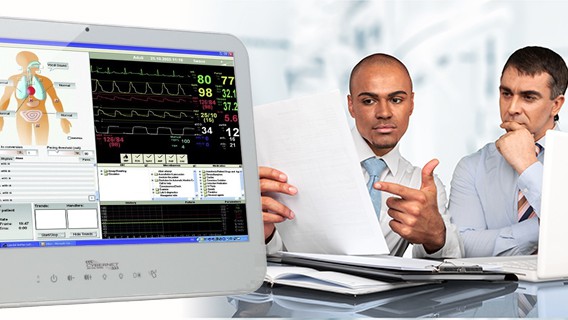Value now plays a big role in health care more than ever and impacts the healthcare system, shifting payment models to value-based purchasing and pay per performance reimbursements. While budgets do not increase, regulatory pressure does alongside expenses and patient numbers. The urge to digitize pushes health care providers to seek affordable solutions that help them lower unit costs, operate more efficiently, and raise their quality levels along with increasing patient satisfaction. Providers are actively looking for ways to optimize the value of their limited resources.
Deploying cost-effective technology results in effective and efficient health care. Prolonging the life of the aging and legacy equipment plays an important role in this transition to a digitized health care. Nearly 5,000 types of medical devices are in use in health care facilities around the world. Reusable electronic medical devices last for 5-15 years, with 8-10 years being the most common lifecycle.
As new systems require wireless connectivity and system-wide interoperability, some legacy equipment that does not have these features may become obsolete before a provider is financially ready to replace it with a newer model. Some organizations are finding innovative solutions to upgrade an existing and aging piece of equipment or integrate it into the new, digital and connected hospital system.
Let’s look at how two organizations are tackling the challenge of upgrading or integrating aging medical equipment into a new system to help cut costs while still improving equipment and allowing them to offer top-of-the-line care at a fraction of the cost.
Peterson Regional Medical Center
Peterson Regional Medical Center (PRMC) needed to upgrade their medication dispensing system with a digital solution. Previously manual, their medication dispensing system was set for an upgrade to make it into a modern, automated system that is also easy to use for the nurses and affordable for the facility. PRMC had powered medical carts with PCs attached in their acute rehab department. However, those units did not perform well given the new medical dispensing software PRMC acquired and the overall scope of medical applications needed more resources than the old PCs could avail.
PRMC considered several options, including the laptops that were discarded due to the limited budget, issues with mounting, safety considerations, and ultimately, the lack of all the benefits of a powerful PC required by resource-hungry medical applications.
The hospital committee opted for an All-in-One PC instead, Cybernet’s iOne-GX31. 17” and 19” touchscreen, wireless, with modest power requirements, this ergonomic solution fit perfectly on the existing Humanscale medical carts. After a rigorous testing and positive feedback from nurses, PRMC ordered 35 units, complete with free disk imaging.
The carts were also supplied with wireless barcode scanners. The nurses found the new system easy to use and efficient. Dispensing medications now comes down to a simple automated process. The nurses now have computerized pharmacy authorizations available on the all-in-one PC on the cart that transports all the medications from room to room. The nurse scans a patient’s armband to view the authorized medications and dosages. Next, the nurse scans the medication to receive the dosage and medication authorization.
The nurses reported highly positive outcomes. They were able to complete extended medication rounds without recharging the carts because the iOne-GX31 is power-efficient and does not consume as much as the old PC they had previously mounted on Humanscale. The accuracy of medication dispense increased, and patients are receiving their medications on time, in the accurate dosage, at all times.
Virginia Commonwealth University Medical Center
Virginia Commonwealth University Medical Center gave a second life to their 8-year old Dräger MDS III Anesthesia Workstations by replacing the obsolete and too expensive to maintain computers with CyberMed H22. The aging computers experienced glitches during procedures, which threatened patient safety and reduced accuracy in EMR documentation and billing. Since anesthesiologists rely on computers to monitor patient vitals and keep accurate documentation during procedures, an upgrade became unavoidable. The old computers were past their warranty term, so the maintenance and repairs became too expensive. Long downtime and slow workflow affected the entire system.
In the modular workstations, the anesthesia machines have longer life cycles than the PCs, so the IT department wanted to extend their use by replacing the PCs. They needed a high-quality, EN60601-1 certified medical PC that can be configured to work with the anesthesia unit and be safe for near-patient use in operating rooms. Antimicrobial* properties protect the computer casing from deterioration and degradation.
The CyberMed H22 models were configured with the existing Dräger anesthesia machines and deployed in operating rooms throughout VCUMC, saving them the cost of replacing the failing legacy computers. The affordable and robust medical computers restored the workflow and quality of care.
Also, an all-in-one workstation simplifies the configuration of the anesthesia cart because there are fewer pieces of equipment, and less wire clutter.
The Key To Integrating Aging Equipment Into A New System Successfully
A medical computer has to offer extensive compatibility, upgradability, and safety features to be apt for the task, though.
Compatibility. When integrating aging equipment into a new system, it is crucial for the new system to come with the legacy ports necessary to connect the older equipment and allow the machine-to-machine communication between the old and the new devices.
Upgradability. When cutting costs is a vital imperative, it is important to deploy technology with affordable upgrade options. For example, medical all-in-one computers often serve dual purposes when they come integrated with RFID reader, CAC or smart card reader, fingerprint ID reader or a barcode scanner. This way, a medical grade computer becomes the connecting link between the aging legacy equipment and the new systems relying on RFID technology that is often part of the infotainment systems.
Safety. With nosocomial infections being a serious liability risk for hospitals, the media and increasingly aware patients scrutinize cases when medical equipment is the source of spread of pathogens. In ICUs, ORs, and other near-patient environments, medical technology must be safe. The casing for many devices like medical computers must be sturdy and waterproof to withstand proper disinfection procedures.
Seamless integration. There are many cases when medical computers can help hospitals connect the large variety of disconnected systems that do not “speak the same language” and bring diverse readings from sensors, monitors, pumps, and newer IoT devices. Whether it be physical devices measuring patient readings, or software that transmits that data to a patient record, an integrated medical computer helps medical professionals bring the readings, analysis and recommendations in one place, refining the care they provide.
As providers integrate new technology, one of the biggest problems is how to stay within the budget and offer top-of-the-line care at the same time. Giving a second life to aging equipment with the help of the new technology helps hospitals postpone the acquisition of new equipment for several years. That way, healthcare facilities can maintain aging equipment functional, and replace it only when it is feasible.
4 Medical Devices that Absolutely Need Integrated Medical Computers
April 9, 2019
The days of enormous computers and huge medical devices are nearly over — as technology advances, it shrinks, and in no field is that more useful than in healthcare. Smaller tech means more mobile and agile medical…
0 Comments8 Minutes
How Medical Computers Are Revolutionizing the Healthcare Industry
October 4, 2015
Medical computers manage patients’ information and allow functions like writing & tracking prescriptions, managing patient billing and tracking all aspects of a patient's medical care. Medical computers are…
0 Comments6 Minutes
You Can't
Learn from a Pop-up
But we can deliver knowledge to your inbox!
We dive deep in the industry looking for new trends, technology, news, and updates. We're happy to share them with you.
Knowledge, News, and Industry Updates Right in Your Inbox




